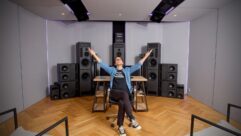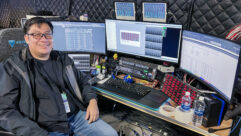
Installation Profile: Practicing High-end Medicine
Sep 1, 2007 12:00 PM,
By Dan Daley
AV infrastructure connects classrooms and hands-on training in UC Davis Education Building
Sidebar

Complications involved in determining the correct type of screen for the education building’s classrooms illustrated the importance of communication between general contractors and systems integrators.
Photos by Gary Wagner Photography
By pure coincidence, I had a doctor’s appointment the same day I was to interview two of the principals involved in the systems integration work for the UC Davis Health System’s newly opened Education Building in Sacramento, Calif. My own doctor’s office is a far cry from the sleek $46.2 million, 121-square-foot edifice that has become the gateway to the University of California, Davis’ 140-acre campus. My doctor’s den is cluttered with a juxtaposition of high technology and the day-to-day detritus of routine examinations and treatment. But, at the core of every medical practice lies a foundation of training. The new educational facility at UC Davis takes a state-of-the-art approach to medical education that is not only interactive, connected, and complex, but also reassuringly easy to operate.
The first students passed through the doors of the new building, which also houses the F. William Blaisdell Medical Library, in January 2007 even as the finishing touches were being installed. In a larger context, the new high-tech training facility brings together the university’s teaching and hospital facilities onto a single campus, a goal of school officials for years.
“The vision for our new facility was inspired by the underlying need to create a central destination that physically and symbolically serves as the hub of UC Davis Health System educational facilities,” says Claire Pomeroy, vice chancellor for Human Health Sciences at UC Davis and dean of the School of Medicine.
The European-inspired steel-and-glass design, created by California-based architect CarrierJohnson, won an award from California Construction Magazine several months ago. The building’s academic mission, as a place where students, faculty, medical staff, and visitors can engage in academic exchange, health-care research, and clinical practice, is ambitious, with a scale and systems complement to match. It includes two 150-seat auditoriums, a 60-seat lecture hall, a clinical skills area with mock exam rooms, high-tech instructional and professional simulation spaces, and a student commons.

In the UC Davis Health System’s new Education Building, the two 150-seat lecture halls are equipped with Sony EVI-D100 cameras and Shure and AKG mics for video-conferencing, surface-mounted Renkus-Heinz TRX121/8 loudspeakers, and ceiling-mounted JBL Control 26CT loudspeakers.
OVERVIEW
At the core of the systems design, the building is divided into two independent operational zones — one for classrooms and the other for clinical skills development, each with its own AMX control system.
“We decided there would be no correlation between the control systems of the two areas because it helps control operating costs,” says Roger Santos, senior support supervisor for medical AV systems for the university’s school of medicine. “Integrating the two areas would have resulted in a single system of increased complexity. This way, it’s much easier for instructors and the students to operate the systems, and that accomplishes what we really want the technology to do, which is empower them.”
However, the two areas are connected in terms of signal path, if not control, via the school’s IP infrastructure, so video and audio of what goes on in one area is available for display in the other. That, Santos says, is an extension of the university medical center’s telemedicine program, in which doctors at the center’s clinics around the state can share audio, video, and data with the physicians at the main hospital for diagnostic applications.
“The idea is that no doctor is alone out there — they have other doctors as shared resources,” Santos says. “The school is based on that same principle.”

Hitachi CPSX 1350 projectors set up in a rear-
projection configuration behind the front wall of the 150-seat lecture halls use mirrors (two per room) to reflect onto a pair of 9’x16’ DS-216H screens from Large Screen Displays.
Within the education building, virtually everything can be recorded. A Canon VC-C50i camera is mounted in the back of each of the building’s 23 classrooms (which seat 12, 16, or 30 students), and a Tandberg Audio Science microphone is hung from the ceiling to record audio in each room. In the three main lecture halls, two Sony EVI-D100 cameras cover the presenter area from the rear, and two EVI-D100 cameras are placed in the front to cover the audience, enabling videoconferencing. Five Shure ULXS124/85 wireless microphones and an AKG CK80 podium microphone cover the presenters and panel speakers.
The Hitachi CP-SX1350 projectors used in the two 150-seat lecture halls are set up in a dedicated room behind each hall’s front wall in a rear-projection configuration and use mirrors (two per room) to reflect onto a pair of 9’×16′ DS-216H screens from Large Screen Displays. There are two 7’×12′ front-projection screens in the 60-seat hall. All screens can display 4:3 and 16:9 aspect ratios. For program audio related to material on screen, the two larger halls use a pair of Renkus-Heinz TRX121/8 loudspeakers surface-mounted on either side of the screens on Renkus-Heinz ball mounts. Distributed audio goes through 33 JBL Control 26CT ceiling-mounted loudspeakers in the larger halls. The smaller hall uses 18 Control 26CT loudspeakers and a pair of JBL Control 29 loudspeakers for program audio.
In the classrooms, JBL Control 25 loudspeakers are ceiling-mounted in the smaller room and JBL Control 28 loudspeakers in the large rooms. Tandberg Audio Science microphones are suspended from the ceiling. AKG CK80 condensers and Shure ULXS124/85 wireless lavaliers and handhelds are used as lectern mics in the lecture halls.
All the information is directed from the classrooms into a central control area on the building’s second floor when encoding, videoconferencing, and/or room routing is required. A Magenta Research matrix switcher routes the audio and video signals to three Envivio Mindshare and two Envivio Mindshare Lite recorder/encoder units, each with a 350MB hard drive attached, interfaced via Jubilant software to two Tandberg conferencing systems (model 6000 and model 3000).

The control room allows the staff to route signals between rooms and allocate resources such as the videoconference units to individual classrooms.
The Envivio units encode video and data into the MPEG-4 format, which will reside on the building’s tiered server system, including the current 1TB host server and a planned 9TB archive server. The system is designed so that any classroom can access the audio and video from any other classroom in realtime via routing patches done on the AMX control panels in the classrooms, once such linkages are approved and scheduled by the systems coordinator in the central control area. Furthermore, any classroom can also recall any of the stored information on an on-demand basis from the server. The network can stream at a near-broadcast-quality 4Mbps. If an AV source outside the building needs to be integrated into a class or videoconference, that can be accomplished using an ISDN line via an IP bridge into the system, although the maximum transfer rate for that would be 1.4Mbps. The system in the control area is accessed via a 17in. AMX NXT-1700 touchpanel.
Larry Woodhill, project manager for SPL Integrated Solutions, the Sacramento-based systems integrator for the UC Davis project, says the recommended practice for the Magenta matrix is to keep all the Cat-5 cable runs of equal length. Given the building’s layout, Woodhill opted to install Magenta video equalizers at the cable entrance to the control room. These adjust the signal according to its distance from the matrix just before the signal is connected to the matrix switcher.
The main cabling for the UC Davis educational systems was substantial, but relatively straightforward, Woodhill says. Herman Electronics’ plenum-rated Cat-5e cables were pulled through cable trays that follow the hallways for the classroom AV feeds and returns to and from the control room.
“The lecture halls got a little tricky because the cable trays were determined by the placement of the HVAC ducting,” he says.
The 30-seat classrooms are fitted with 15 two-person desks, each of which has an integrated PC and a 17in. Dell LCD monitor, with a glass protective shield over the monitor to allow the tandem teams of students to do “wet” lab work, such as dissections. All the classrooms have a Vaddio WallView 50i PTZ camera system mounted on the rear wall for remote viewing, videoconferencing, and local recording. Each classroom also has its own media cabinet housed in a Middle Atlantic 24RU-50 enclosure with a built-in PC, a Biamp Nexia audio DSP mixer/amplifier, an Autopatch RGB router, and a Sony RDR-VX515 DVD/VCR combo player.

As the screenshot at right shows, if a user in a classroom tries to access a resource that the staff hasn’t assigned to that classroom, the touchpanel displays an error and instructions to contact the help desk.
CLINICAL STUDIES SUITES
The high-tech thread also runs through the clinical studies area of the building, but the ambience there changes from academic to hands-on. Eight mock examination rooms are physically connected by a hallway, but even more extensively connected via technology.
In these rooms student doctors learn to interact with live patients as part of their studies. But instead of an instructor monitoring each student, or a group of students crowded around a single patient, a single instructor can supervise all eight exam rooms and a nearby 25-seat classroom simultaneously, unobtrusive until their assistance is needed. The instructor works from a control room off the main corridor.
Each room has two Sony WVCS574 ceiling-mount PTZ cameras and a pair of Crown CM-30W ceiling-mounted microphones, all placed inconspicuously above eye level. JBL Control 24C Micro loudspeakers are placed in the ceiling. Using a Panasonic WJ-HD316A 16-channel DVR switcher, two Sony FWD-32LX2 32in. LCD screens in the control room bring up the cameras in each room, which are controllable from the instructor’s station. A Sennheiser HMD280-XQ headset provides for two-way audio communications between the instructor in the control room and the student in the exam room, hallway, or classroom.
The connectivity starts even before students enter the exam rooms: The entrance to each has its own PC station where the student logs in and initiates the exam procedure, under the watchful eye of a Sony WVCF284 camera, viewing the scenario created by the instructor for that patient. Data entered here, and the audio and video from the exam room, are sent to the control room and on from there to the central server room within Clinical Studies. There, it becomes, like all other data, retrievable on demand for review by students and teachers.
B-LINE AND VBRICK

A PC station outside each mock exam room in the clinical studies area lets each student log in and view a scenario created by an instructor supervising from a nearby control room.
In addition to keeping the system straightforward to use and maintain, Santos notes another reason that the clinical studies area dwells in its own technology universe. The AV systems are largely built around Clinical Skills System, a program from B-Line Medical that can program examination scenarios, monitor students’ approach and interaction with patients, and report and score their work. It then delivers data and results using a VBrick encoder to the central server facility, all with control over the AV systems integrated into the software.
The B-Line software enables the data and the video stream to be stored with corresponding file tags on the server so that when a student or instructor retrieves the file, both data and video content are linked together and stored in the central server facility. (The 12- and 16-seat classrooms on the other side of the building also have one-way AV connections to the exam rooms. Students in the clinical studies area can watch and hear what goes on in the classrooms but cannot interact with them.)
“The B-Line [software] acts as the front end to the control system, directing the AMX, whereas on the classroom side, the AMX does the heavy lifting in terms of control,” Santos says. “The components of the systems in the Clinical Studios suites area were all built upon what’s needed by the examination software.”
The systems at UC Davis’ new educational facility are complex, but Santos says the proof of the validity of the design is in the transparency of their operation. The process may have had a bump or two along the way, but its execution has been virtually flawless since it powered up.
“A lot had to do with the programming, which was very intuitively laid out,” he says.
“Most single-room systems are simple enough that we can write the code without much advance planning, but with a project the size of UC Davis, we spent a [full] day on software engineering, where we designed the architecture of the system before writing any code,” says Todd McLaughlin, programmer for Stanford, Calif.-based interactive services agency WireSpeed. “We figure out how and when the rooms will communicate with each other, what data they need to share, and how to store that data. Skipping this step can cost days of rewriting code later on. If the previous two steps were done correctly, writing the code is a bit anticlimactic.”
And that’s just the way everyone likes it, Santos says, noting that the entire system can be maintained by a handful of full-time employees.
“They work as curriculum coordinators and are the front-line setup people when instructors need help with any of the systems,” he says.
Medical science is only going to get more complicated, as officials at UC Davis know well. Thanks to the new facility, students learning medicine at the university are allowed to go about it in a particularly sophisticated way.
AKG Acoustics
www.akg.com
For More Information
AMX
www.amx.com
Autopatch
www.autopatch.com
Biamp
www.biamp.com
B-Line Medical
www.blinemedical.com
Canon
www.usa.canon.com
Crown
www.crownaudio.com
Dell
www.dell.com
Envivio
www.envivio.com
Herman Electronics
www.hermanelectronics.com
Hitachi
www.hitachi.us
Magenta Research
www.magenta-research.com
Middle Atlantic
www.middleatlantic.com
Panasonic
www.panasonic.com
Renkus-Heinz
www.renkus-heinz.com
Sennheiser
www.sennheiserusa.com
Shure
www.shure.com
Tandberg
www.tandberg.com
Vaddio
www.vaddio.com
VBrick
www.vbrick.com
Dan Daleyis a veteran freelance journalist and author specializing in media and entertainment technology and business sectors. He lives in New York, Miami, and Nashville, Tenn., and can be reached at[email protected].
The UC Davis Education Building’s classrooms all have image projection and 16:9 screens. However, only the largest of three types of rooms have motorized retractable screens. The reason for that is a cautionary tale about the issue of coordination between designer and general contractor.
“Everyone who worked on this project was great,” says Roger Santos, senior support supervisor for medical AV systems for the UC Davis School of Medicine. “But there are certain facts of life that come with putting together complex buildings like this, and one of them is that GCs tend to focus on the construction of a room, not what its ultimate functionality will be. There’s an informational gap in between there that is really tough to root out.”
In this instance, HVAC ducting ran exactly where motorized screens would have needed to be placed in the two smaller room designs, necessitating the installation of manual pulldown screens instead.
Lessons Learned
But other preplanning moves enhanced the project. Given that there would be three types of classrooms with three different room sizes, the initial specification called for three manufacturers supplying as many as five different projector models. Santos says his management team, led by Rick Sprunger and Jan Dickens, saw the inefficiency in that from a cost-effectiveness, operational, and maintenance perspective, and convinced the school of medicine to instead order a single type of projector — in this case, an Hitachi CPSX 1350 — adding short-throw lenses for projectors used in the smaller spaces to account for differing room configurations.
“We caught that just hours prior to the actual purchase by the installer,” he says. “That’s the value of looking at a space from the point of view of functionality and use, as opposed to just looking at it mechanically.”
Another example was the decision to replace what would have been a table-mounted gooseneck microphone on the auditorium’s student tabletops with ceiling-mounted microphones.
“That not only cut down enormously on the amount of cabling that would have to have been run, but also took into account the fact that microphones on lecture hall tables would have been subject to a lot of wear and tear over time, requiring maintenance and ultimately replacement,” Santos says. “The ceiling microphones may not be as absolutely clear as a gooseneck, but with some light acoustical treatment to the walls and the equalization applied by SPL, they are more than sufficiently intelligible for lecture hall Q&As.”
Woodhill discovered another point worth remembering for the future once the installation was finished.
“The kids sometimes seem to like to mess around with the cameras, which is not unexpected with students,” he says. While the cameras mounted on the front walls of the classrooms are recessed, the rear-wall cameras are completely exposed and accessible, and it would be a less-than-simple matter to try to recess them now, he says. The school is looking into a solution to that challenge.
— D.D.










